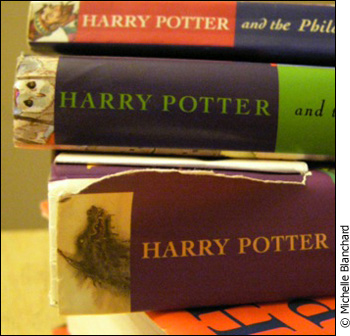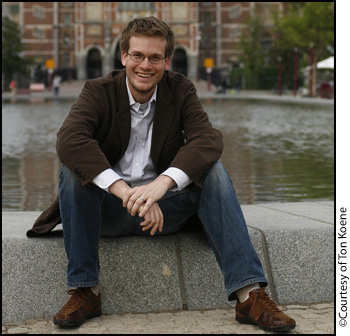Tags
Related Posts
Share This
Where the teen books are
Fourteen-year-old Madelyn Newman doesn’t have Twitter and spends about 15 minutes a day on Facebook. But give her a book and she will read for hours.
Right now she’s splitting her attention between Ned Vizzini’s young adult novel, It’s Kind of a Funny Story, about a New York teen who finds himself in a mental ward after he attempts suicide, and Never Let Me Go, Kazuo Ishiguro’s 2005 novel about a boarding school full of child clones bred for the harvesting of organs. She’s read many of the works of Stephen King and is now embarking on the challenge of Shakespeare with delight.
“I’ll go on Facebook if I have absolutely nothing else to do and I have no book,” she says.
Newman’s reading habits fly in the face of conventional wisdom that says that teens don’t read. The statistics are pretty grim. A 2004 report called “To Read or Not to Read” showed that only 22 percent of 17 year olds read for fun: a drop from 31 percent in 1994.
And yet, over the last five years, Canadian book giant Indigo has seen sales of young adult literature increase 150 percent, while the company’s overall sales have struggled. Recently, the company announced that it would increase the sale of lifestyle products while pulling back on its book stock. But Indigo’s young adult list just keeps growing.
Coming of age
The slow boom in teen lit began in 1997 with the first installment in a book series about a boy named Harry Potter.
“Rowling decided to do something that is going to change everything in publishing,” says Anita Silvey, author of 500 Books for Teens (2006). “She decides to age Harry one year with each volume, which means that by the third and fourth volume — which are selling more copies than any other book in the world — we now have a teenager at the core of the story.”

Magical influence. J.K. Rowling’s Harry Potter series has energized and utterly reshaped the young adult book market.
Anyone with an Internet connection knows what happens next: Pottermania builds into a multibillion-dollar franchise; Rowling becomes the richest woman in the U.K.; millions of children and adults eagerly devour the seven-part series until it comes to a close in 2007. Happy ending.
But things were just beginning to change for the teen literature industry.
“We’re now in a post–Harry Potter world,” says Silvey. “The minute you have a formula of the best-selling book in the world with teenagers in it, everyone in every [publishing] house was looking to see, Is there any way we can duplicate the success?”
Thus began a flood of fantasy, sci-fi, paranormal and dystopian novels for teens, all striving to capture Potter’s success. It was quite a departure from the prior standard teen literature.
“The young adult novels they developed in the ’50s, ’60s, ’70s, they were all realistic fiction about teens having problems,” Silvey says. “They were all Catcher in the Rye.”
A best-selling book with teenagers in it? ‘Everyone asked, Is there any way we can duplicate the success?’ — book expert Anita Silvey
In 2005, another book aimed at the younger set became an international bestseller and merchandising sensation: Twilight. Another trajectory everyone knows: All four books in the series occupied the New York Times Best Seller List, and Twilight-mania is still at fever pitch, with the final movie installment on the horizon. But the story doesn’t stop there.
Keeping lightning in a bottle
Between the Potters and the Twilights, a steady community of avid readers, teens most definitely included, has risen up from the Internet and vocalized their voracious thirst for books. Authors and publishers are now using the Internet to find and connect with fans, learn what the trends are, and serve up exactly what teen readers want, often with impressive results.
John Green is a novelist whose first book, Looking for Alaska, won the 2006 Printz Award, which recognizes excellence in young adult literature. Since 2007, Green has been building an online fan base through video blogs, message boards and Twitter. In June 2011, Green announced the title of his most recent book, The Fault in Our Stars, along with a promise to sign every single pre-ordered copy of the novel. Within hours, the book was the number one bestseller on Amazon.com and Barnes and Noble. At the time, it was unfinished and without a cover.

Youth-market novelist John Green has found wild success online.
Green, whose fans also include adults, is one of many young adult authors who has a presence online. Widely-read writers like Libba Bray (A Great and Terrible Beauty), Maureen Johnson (13 Little Blue Envelopes), Scott Westerfeld (Uglies) and even Judy Blume (Tales of a Fourth Grade Nothing; Are You There God? It’s Me, Margaret) have taken to Twitter and blogs as places to talk one-on-one with their fans.
“They have placed themselves where teens might go. The young adult writing crowd is very, very present in this cyber-space community. It gives them a chance to connect directly to their readers,” says Silvey.
Biblio file sharing
Indigo representative Lisa Huie says the company is taking full advantage of the popularity of teen literature. Last year, the company launched their Teen Read Awards, with 15,000 teenage fans voting online for their favourite novels. The company hosts regular events and promotions for their lucrative teen literature branch, but the true engine of buzz is of course teenagers themselves.
“Reading is and always has been a social activity. It started with book clubs; now it’s text messaging,” says Huie. She adds that teens have no problem using the Internet to find out more about their favourite authors.
“It’s always been a part of their lives,” she says. “Why wouldn’t they use that tool to leverage their experience?”
“This is obviously a culture where they share with each other what they find,” says Silvey. “Whether it’s the latest style or the latest book they’ve read, there seems to be an enormous underground movement of passing things around to friends.”
“Brianna [Wiederhold, 14] and I will read something and tell each other to read it,” teenager Newman says. Both girls have been devouring the James Patterson sci-fi series Maximum Ride. “Brianna read it, and then I read it, and then we got everyone else to read it because we thought it was so good.”
With the movie business churning out film adaptations of popular teen novels at a feverish pace (coming soon is the highly anticipated movie version of Suzanne Collins’s The Hunger Games) there’s some question as to whether the teen literature craze can last. But Silvey doesn’t see this boom going anywhere. The reason? Demographics: The teenage population is bigger than ever.
“There’s a huge teen bubble moving through the population,” says Silvey. “There are a lot more teens, and there’s a lot more publishing for them.”
So while Rowling has moved on to bigger and more virtual things post-Potter (namely, the creation of Pottermore, an “exciting online experience” based on the books), there seems to be no stopping the young adult authors and publishers looking for their own runaway hit.
In the meantime, readers like Newman will be reaping the benefits.





